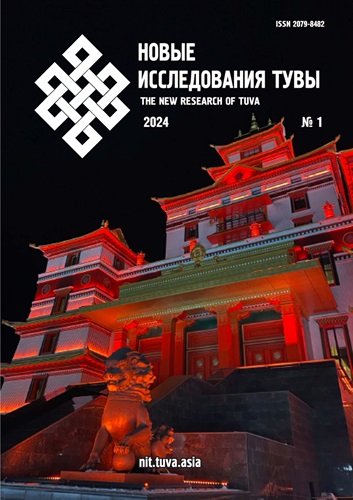Метафорическая репрезентация времени в русской и тувинской языковой картине мира
DOI:
https://doi.org/10.25178/nit.2024.1.7Ключевые слова:
метафорическая репрезентация; языковая картина мира; метафора; русский язык; тувинский язык; категория времени; понимание времениАннотация
Статья посвящена сравнительно-сопоставительному анализу языковых средств выражения метафорического представления категории времени в русском и тувинском языках. Цель исследования — установление особенностей метафорической репрезентации категории времени средствами флективного русского языка и агглютинативного тувинского языка. Предмет исследования — метафорические словосочетания со словами «время», «үе» ‘время’, «шаг» и «шак» ‘час’. Материалом для исследования служили лексикографические источники. Использованы методы лексикографического и компонентного анализа.
Рассмотрены две модели времени — модель, связанная непосредственно с самим временем (модель Потока времени) и модель, ориентированная на человека (модель Пути человека). Отмечены особенности членения того или иного смысла выражений со словами «время», «үе» ‘время’, «шаг» и «шак» ‘час’ на значения в типологически разных языках. Выявлено, как единое мыслительное содержание передаётся различными языковыми средствами в событийном флективном русском языке и статичном агглютинативном тувинском языке.
Сходства выражения категории времени основаны на присутствии в обоих языковых картинах мира универсальных метафорических моделей: время — движение, необратимое движение, движение с разной скоростью, время, движущееся со средней скоростью. Различия связаны с лексическим выражением категории времени: в русском языке — с помощью глаголов либо фразеологизмов, в тувинском — с помощью словосочетаний, содержащих существительные, прилагательные, глаголы и наречия.
Библиографические ссылки
Арутюнова, Н. Д. (1999) Язык и мир человека. 2-е изд., испр. М. : Языки русской культуры. 896 с.
Арутюнова, Н. Д. (1997) Время: модели и метафоры // Логический анализ языка. Язык и время / отв. ред. Н. Д. Арутюнова, Т. Е. Янко. М. : Индрик. 352 с. С. 5–16.
Бахтикиреева, У. М., Валентинова, О. И. (2022) Особенности «языкового мышления» с позиций системной лингвистики // Russian Journal of Linguistics. Т. 26. № 1. С. 224–244. DOI: https://doi.org/10.22363/2687-0088-30149
Берницкая, Н. В. (2019) О грамматической оппозиции глаголов движения типа идти / ходить в русском языке // Вопросы языкознания. № 1. С. 75–92. DOI: https://doi.org/10.31857/S0373658X0003596-4
Гак, В. Г. (1997) Пространство времени // Логический анализ языка. Язык и время / отв. ред. Н. Д. Арутюнова, Т. Е. Янко. М. : Индрик. 352 с. С. 122–131.
Кара-оол, Л. С. (2015) Понятие «час» по-тувински // Филологические науки: вопросы теории и практики. № 2 (44). С. 99–103.
Красухин, К. Г. (1997) Три модели индоевропейского времени на материале лексики и грамматики // Логический анализ языка. Язык и время / отв. ред. Н. Д. Арутюнова, Т. Е. Янко. М. : Индрик. 352 с. С. 62–78.
Крейдлин, Г. Е. (1997) Время сквозь призму временных предлогов // Логический анализ языка. Язык и время / отв. ред. Н. Д. Арутюнова, Т. Е. Янко. М. : Индрик. 352 с. С. 139–152.
Кужугет, Ш. Ю. (2014) Лексико-семантическое поле «природное время» в прозе К.-Э. Кудажы // Филологические науки: вопросы теории и практики. № 5. Ч. 2. С. 119–122.
Куулар, Е. М. (2016) Лексика народного календаря в юго-восточном диалекте тувинского языка // Вестник Калмыцкого университета. № 2. С. 110–116.
Ламажаа, Ч. К. (2018) Тувинское время и экономическая культура тувинцев // Новые исследования Тувы. № 2. С. 4–21. DOI: https://doi.org/10.25178/nit.2018.2.1
Ламажаа, Ч. К. (2021) Очерки современной тувинской культуры. СПб. : Нестор-История. 192 с.
Монгуш, Д. А. (1958) Настоящее заглазное время в тувинском языке // Учёные записки Тувинского научно-исследовательского института языка, литературы и истории / отв. ред. Н. А. Сердобов. Кызыл : Тувинское книжное издательство. Вып. 6. 307 с. С. 111–114.
Монгуш, Д. А. (1959) О временных формах в тувинском языке // Учёные записки Тувинского научно-исследовательского института языка, литературы и истории / отв. ред. Н. А. Сердобов. Кызыл : Тувинское книжное издательство. Вып. 7. 302 с. С. 85–92.
Ооржак, Б. Ч. (2014) Временная система тувинского языка. М. : Языки славянской культуры. 184 с.
Плунгян, В. А. (1997) Время и времена: вопрос о категории числа // Логический анализ языка. Язык и время / отв. ред. Н. Д. Арутюнова, Т. Е. Янко. М. : Индрик. 352 с. С. 159–170.
Потапов, Л. П. (1969) Очерки народного быта тувинцев. М. : Наука. 402 с.
Сузукей, В. Ю. (2009) Пространство и время в традиционной тувинской культуре // Новые исследования Тувы. № 1–2. С. 250–267.
Тува: Родная земля (2023) / Ламажаа Ч. К., Сувандии Н. Д., Кужугет Ш. Ю., Майны Ш. Б., Санчай Ч. Х. / под ред. Ч. К. Ламажаа, Н. Д. Сувандии. СПб. : Нестор-История. 344 с.
Шамина, Л. А. (1987) Временные полипредикативные конструкции тувинского языка / отв. ред. М. И. Черемисина, Д. А. Монгуш. Новосибирск : Наука. 137 с.
Шамина, Л. А. (2019) Лексема шаг ‘время’ и вопросы грамматикализации в тувинском языке // Новые исследования Тувы. № 2. DOI: https://doi.org/10.25178/nit.2019.2.16
Kuzhuget, Sh. Yu. (2017) Тraditional Notion of Time of Nomadic Tuvinians // Journal Siberian Federal University. № 10 (7). C. 965–969.
Опубликован
Как цитировать
For citation:
Arsenyeva I. A. and Kuular E. M. Metaphorical representation of time in the Russian and Tuvan language picture of the world. New Research of Tuva, 2024, no. 1, pp. 104-120. (In Russ.). DOI: https://doi.org/10.25178/nit.2024.1.7
Выпуск
Раздел

Это произведение доступно по лицензии Creative Commons «Attribution-NonCommercial» («Атрибуция — Некоммерческое использование») 4.0 Всемирная.

Автор (лицензиар) произведения предоставляет простую (неисключительную) лицензию на использование редакцией (лицензиатом) произведения науки, который заключается в упрощённом порядке (открытая лицензия), согласно ст. 1286.1. «Открытая лицензия на использование произведения науки, литературы или искусства» Гражданского кодекса Российской Федерации.
В нашем издании публикуемые материалы доступны по лицензии Creative Commons «Attribution-NonCommercial» («Атрибуция — Некоммерческое использование») — CC BY-NC.
Т. к. лицензия открытая, автор имеет право разместить статью после ее выхода на своем сайте, читатель может скопировать и разместить на своих персональных ресурсах, в том числе в виде выдержек, конспектов, но:
а) обязательно должно быть указано ФИО автора, неизмененное название статьи и гиперссылка на первоисточник (журнал «Новые исследования Тувы»),
б) размещающий не имеет права брать деньги за доступ к этому материалу или каким бы то ни было образом давать преимущество одним читателям над другими,
в) при перепечатке автором текста статьи без значительных изменений (если сохраняется 30% текста или более) должно быть указано, что первая редакция статьи вышла в журнале «Новые исследования Тувы» и сделана соответствующая ссылка.
Лицензия действует по всему миру, длится в течение срока авторских прав на произведение, является неотзывной.










